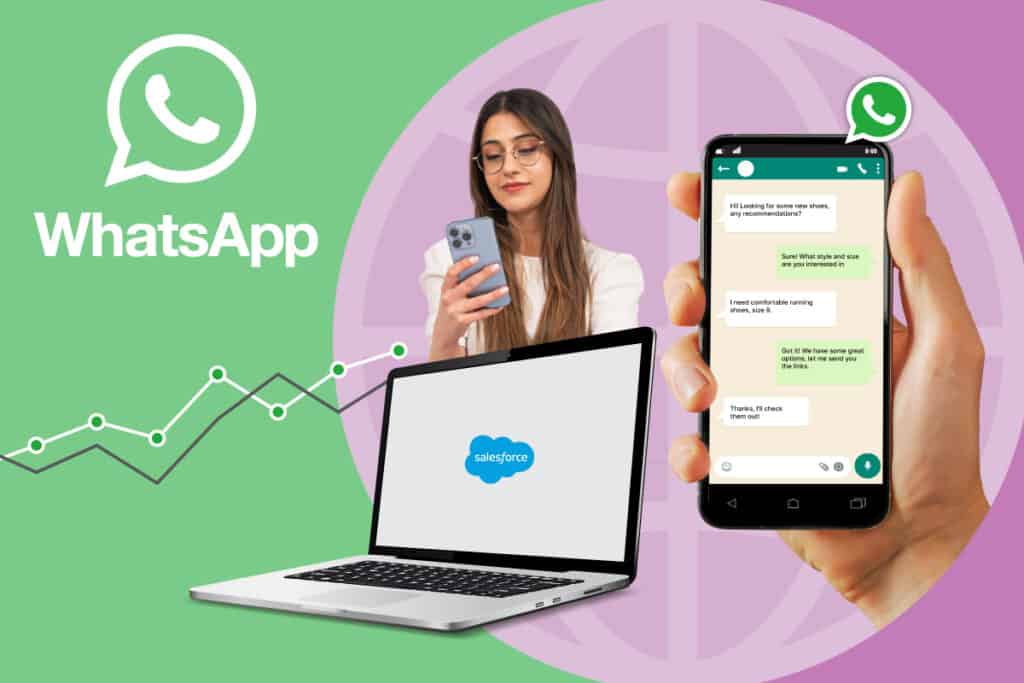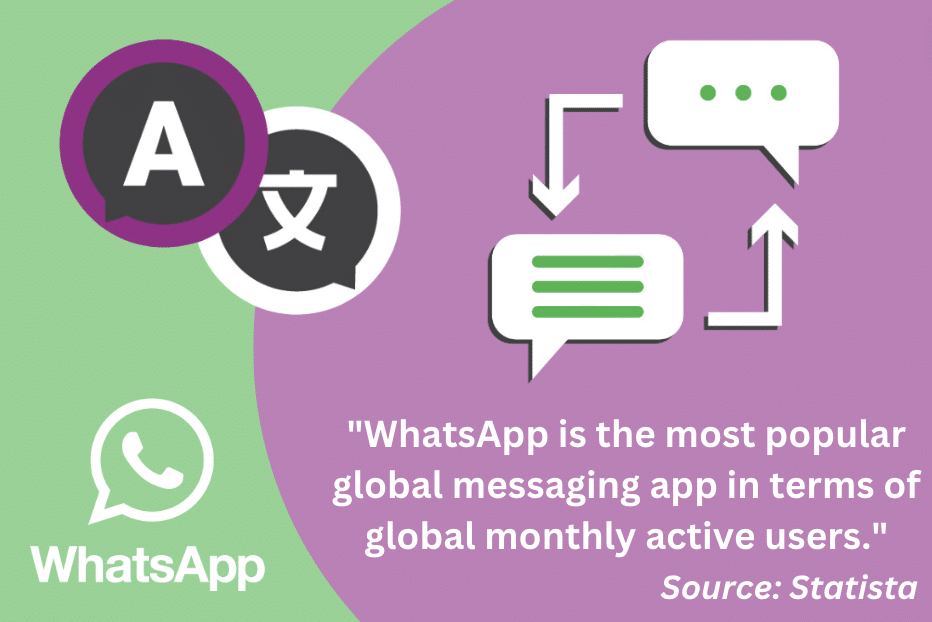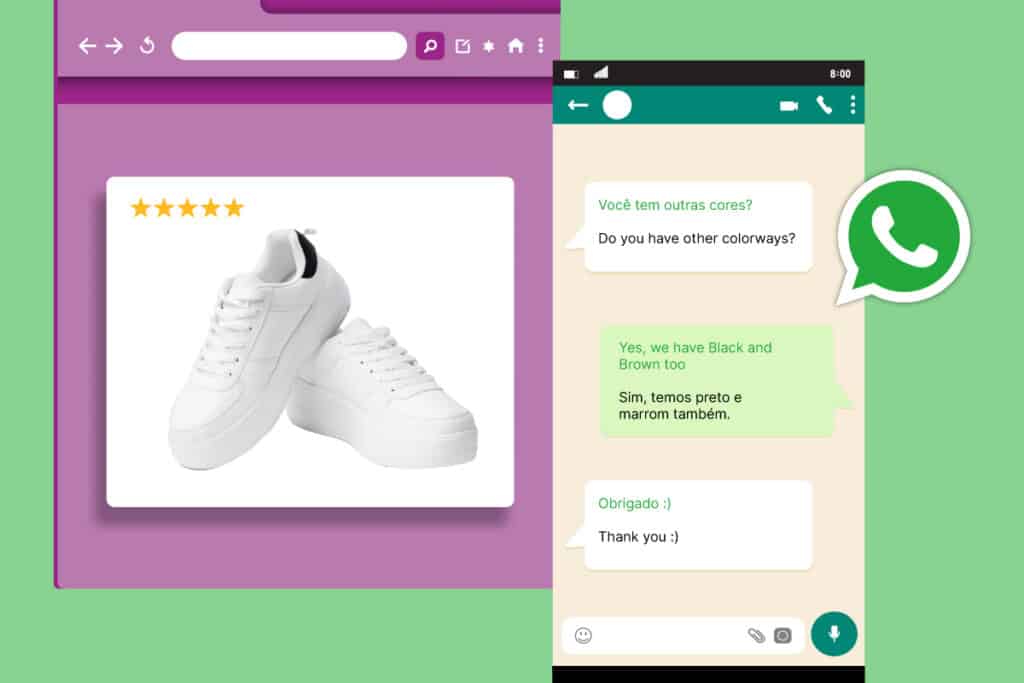Top 9 Reasons Your Brand Needs Translation for WhatsApp

These days, the vast majority of consumers with smartphones have at least one messaging app. Increasingly, they’re using these apps to connect with brands – whenever and wherever a need arises.
In fact, 66% of online adults say messaging is their preferred way of communicating with a business. That number is even higher – 72% among 18-34-year-olds.
66% of online adults say messaging is their preferred way of communicating with a business.
Source: WhatsApp
There are a lot of messaging apps out there. But there’s one that leads the pack: WhatsApp.
Brands must have a plan in place to engage with consumers via WhatsApp – or risk losing out to a competitor.
Last year at Dreamforce, Salesforce announced an exciting partnership with WhatsApp. According to Salesforce, this partnership allows businesses using the CRM to “connect with their customers and build new messaging experiences on WhatsApp.”
Essentially, the partnership provides a great opportunity for brands to engage with their customers throughout the purchase journey – via a familiar, beloved channel.
However, there’s something missing from this partnership: the ability to translate WhatsApp messages through Salesforce.
Why does that even matter? In this blog, we’ll share 9 of the top reasons your brand needs translation capabilities for WhatsApp.
Reason #1: Your Customers Are Already Using WhatsApp
Earlier, we mentioned that WhatsApp leads the charge when it comes to messaging apps. And there’s data to back that claim.
As of January 2023, WhatsApp is the #1 global messaging app in terms of monthly active users. And it wins that title by a long shot.

Two billion users access WhatsApp on a monthly basis. In comparison, WeChat – the second most popular global messaging app – has about 1.3 billion users.
There are some messaging apps that are popular regionally. But WhatsApp has a global appeal. According to a recent article, WhatsApp is the most popular messaging app in more than 100 countries.
Sure, consumers use WhatsApp to communicate with family and friends. But increasingly, they use it to connect with brands, too. According to 1440 research from 1440, 36% of consumers are currently using (or open to using) WhatsApp Business Messages.
36% Of consumers are currently using – or open to using – WhatsApp Business Messages.
1440 Consumer Communication Preferences Survey
The bottom line is, your customers are already using WhatsApp. In today’s competitive marketplace, you simply can’t afford not to engage with them via this hugely popular channel.
Reason #2: Nearly Every Brand is a Global Business
In the past, consumers’ shopping options were limited by geography. They’d shop for footwear at their local shoe store. And they’d pick up cosmetics at the nearby department or drugstore.
Today, that’s no longer the case.
In fact, it’s often quite easy for a consumer to make a purchase from a brand halfway across the world. And oftentimes, that’s exactly what they do. Per an article for Performance Marketing World, seven in ten US consumers have shopped online with a brand or retailer outside of the country in the past year.
Consumers expect native language communication when doing business with a brand in a different country. According to recent 1440 research, 82% of consumers expect a brand in a different country with a different language to be able to communicate with them in their own language at least sometimes.
83% Of consumers expect a brand in a different country with a different native language to be able to communicate with them in their own native language at least sometimes.
1440, A Guide to Consumer Translation Preferences
If you’re a brand that sells internationally, you must be able to break down language barriers in WhatsApp to connect with your shoppers – wherever they are.
Reason #3: Even Within a Single Country, There are Language Barriers
Let’s say you’re a brand that only does business in your own country. You’re still bound to run into language barriers when interacting with customers via WhatsApp.
Case in point? Per the US Census Bureau, nearly a quarter of the population speaks a language other than English at home.
Consumers expect brands to break down those language barriers. According to a recent survey, 89% of consumers expect a brand in the same country, but with a different language, to be able to communicate with them in their preferred language at least sometimes.
89% Of consumers expect a brand in the same country (but a different native language) to be able to communicate with them in their preferred language at least sometimes.
1440, A Guide to Consumer Translation Preferences
So, don’t think you’re off the hook if you only sell in your own country. Translation capabilities in WhatsApp are still a must.
Reason #4: Consumers Expect Native Language Messaging
As we’ve already mentioned, consumers expect native language communication – whether they’re interacting with a brand in the same country or a different one.
But do they actually expect native language communication via messaging channels like WhatsApp?
Absolutely. Per our own research, a staggering 92% of consumers say they expect a brand to communicate with them in their native language via messaging at least sometimes.
It’s imperative to have the right tools to deliver native language experiences via WhatsApp.
Reason #5: Native Language Experiences Via WhatsApp Drive Sales
Clearly, consumers expect native language communication via messaging apps including WhatsApp. What happens when brands meet those expectations?
They’re more likely to make an initial purchase.
Per CSA Research, 76% of consumers prefer purchasing products with information in their own language. Furthermore, 65% prefer content in their own language – even if the quality is poor. But don’t settle for poor quality! There’s a proven solution that delivers accurate translations. More on that in reason #9.
Reason #6: Native Language Experiences Via WhatsApp Boosts Loyalty and Lifetime Value
It’s no secret that satisfied customers are more likely to make another purchase in the future. Delivering winning products and services is a big piece of the puzzle. But so too is delivering winning experiences via the customer’s preferred channel (which increasingly is WhatsApp), in their preferred language.
According to CSA Research, three-quarters of consumers are more likely to make a repeat purchase from a brand if the service is available in their preferred language.
3/4 of consumers are more likely to make a repeat purchase from a brand if the service is available in their preferred language.
CSA Research
Reason #7: Hiring and Retaining Multilingual Resources is Tough – and Costly
It’s a tough time to hire talent. Budgets are shrinking. And oftentimes, it’s simply hard to find the talent you need.
Hiring multilingual talent is even harder.
Even if you are able to recruit and hire multilingual resources, there’s no guarantee they speak all the languages your customers do. You’re still bound to run into language barriers. As such, you must have the right tools to break those barriers down via WhatsApp.
Reason #8: Manual Translation is Time-Consuming
Today, there are many machine translation services available, including Google Translate, Microsoft Translate, and DeepL, among others. Machine translation has come a long way. But copying and pasting WhatsApp messages into one of these engines is a clunky, time-consuming process – with plenty of room for error. And chances are, your support teams don’t have much time to spare.
What’s more, 83% of consumers expect immediate engagement when they reach out to a company. If a brand is running manual translations, they’re not in a great position to meet those expectations.
By automating translations in WhatsApp, you’re equipped to break down language barriers – without sinking a ton of time into doing so. Your customers’ expectations are met. And, your agents can use their time to deliver winning experiences.
Reason #9: There’s a Proven, Existing Solution at Your Fingertips
For any business challenge, there are multiple solutions that promise to solve it. But oftentimes, those solutions come with a steep learning curve. Or, they take a long time to implement – which means you won’t see value for quite a white.
Another option is to build your own translation solution in-house. But that takes time. And it means you have to pull talent off of other valuable projects and initiatives in order to build and support the solution.
The good news is, there’s already a proven solution that makes it easy for you to automatically translate WhatsApp messages within Salesforce: Translation Studio from 1440.
With Translation Studio, you can quickly and accurately translate WhatsApp conversations in 100+ languages – right within the Salesforce platform.
Let’s say you’re a footwear brand based in the US, but you sell your products across the globe. A prospective customer from Portugal reaches out to you via WhatsApp to ask some questions about your products. The message is automatically translated from Portuguese to English. Then, the customer care agent types their response in English – and it’s automatically translated to Portuguese before it goes to the customer.

Translation Studio automates WhatsApp translation in Salesforce. That means there’s no steep learning curve or extra time or effort required of your support team members.
In addition, Translation Studio is easy to integrate; you can be up and running quickly. And that means you’ll start to see value quickly.
We’re living in the age of AI. With Translation Studio, you can tap into that AI to deliver native language conversation experiences via WhatsApp – all without leaving the Salesforce platform.
Start Breaking Down Language Barriers Via WhatsApp
WhatsApp is the #1 global messaging app. And increasingly, consumers are using it to connect with brands throughout the purchase journey.
Today, language barriers are bound to happen in WhatsApp – whether you’re interacting with consumers in the same country or another one. It’s essential to have the right technology in place to break down these language barriers to deliver native language communication via WhatsApp.
Ready to see how Translation Studio from 1440 can empower your brand to communicate with any customer in any language through WhatsApp – without leaving Salesforce? Contact us to see Translation Studio in action.